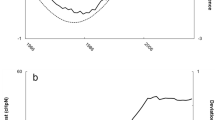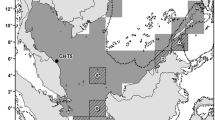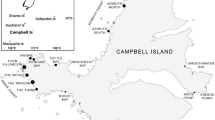Abstract
The El Niño Southern Oscillation (ENSO) is the predominant interannual pattern of climate variability in the world and may become extreme approximately once every 20 years. Climate-forced interannual variability in fecundity rates of long-lived species are well-studied, but the effect of extreme events is less clear. Here, we analyzed the effect of the extreme 2015–16 El Niño event on three long-lived sea turtle species in a region highly influenced by ENSO. The effect of this extreme event varied considerably among species. While reproductive success dramatically declined in leatherback turtles (Dermochelys coriacea), the reduction was only marginal in green turtles (Chelonia mydas). Nevertheless, the number of nesting green turtles decreased following the extreme El Niño event, likely due to decreased ocean productivity. We used global climate models to project an increase in the decadal occurrence of extreme events from ~ 0.7 events (beginning of twentieth century) to ~ 2.9 events per decade (end of twenty-first century). This resulted in a projected decline in the reproductive success of leatherback turtles (~ 19%), a milder decline in olive ridley turtles (Lepidochelys olivacea) (~ 7%), and no decline in green turtles (~ 1%). Extreme El Niño events can have a strong detrimental effect on East Pacific leatherback turtles, a population that is already critically endangered due to other anthropogenic impacts. Our results highlight the importance of conducting species-specific and site-specific analyses of climatic impacts on sea turtles.




Similar content being viewed by others
References
Barnard PL, Hoover D, Hubbard DM et al (2017) Extreme oceanographic forcing and coastal response due to the 2015-2016 El Niño. Nat Commun 8:14365
Broderick AC, Godley BJ, Hays GC (2001) Trophic status drives interannual variability in nesting numbers of marine turtles. Proc R Soc Lond B 268:1481–1487
Cai W, Borlace S, Lengaigne M et al (2014) Increasing frequency of extreme El Niño events due to greenhouse warming. Nat Clim Chang 4:111–116
Cai W, Wang G, Santoso A et al (2015) Increased frequency of extreme La Niña events under greenhouse warming. Nat Clim Chang 5:132–137
Chavez FP, Strutton PG, Friederich GE, Feely RA, Feldman GC, Foley DG, McFadyen MJ (1999) Biological and chemical response of the equatorial Pacific Ocean to the 1997-98 El Niño. Science 286:2126–2131
Dornfeld TC, Robinson NJ, Santidrián Tomillo P, Paladino FV (2015) Ecology of solitary nesting olive ridley sea turtles at Playa Grande, Costa Rica. Mar Biol 162:123–139
Fonseca LG, Murillo GA, Guadamúz L, Spínola RM, Valverde RA (2009) Downward but stable trend in the abundance of arribada olive ridley sea turtles (Lepidochelys olivacea) at Nancite beach, Costa Rica (1971-2007). Chelonian Conserv Biol 8:19–27
Fonseca MG, Anderson LO, Arai E et al (2017) Climatic and anthropogenic drivers of northern Amazon fires during the 2015-2016 El Niño event. Ecol Appl 27:2514–2527
Gaillard JM, Festa-Bianchet M, Yoccoz NG (1998) Population dynamics of large herbivores: variable recruitment with constant adult survival. Trends Ecol Evol 13:58–63
Gates CE, Valverde RA, Mo CL, Chaves AC, Ballestero J, Peskin J (1996) Estimating arribada size using a modified instantaneous count procedure. J Agric Biol Environ Stat 1:275–287
Heppell SS, Snover ML, Crowder LB (2003) Sea turtle population ecology. In: Lutz PL, Musick JA, Wyneken J (eds) The biology of sea turtles, vol II. CRC Press, Boca Raton, pp 275–306
Honarvar S, O’Connor MP, Spotila JR (2008) Density-dependent effects on hatching success of the olive ridley tutle, Lepidochelys olivacea. Oecologia 157:221–230
Howard R, Bell II, Pike DA (2014) Thermal tolerances of sea turtle embryos: current understanding and future directions. Endanger Species Res 26:75–86
IBM Corp. Released (2016) IBM SPSS statistics for Macintosh. Version 24.0. IBM Corp, Armonk
IPCC. Climate Change (2013) In: Stocker TF et al (eds) The Physical Science basis. Contribution of working group I to the fifth assessment report of the Intergovernmental Panel on Climate Change. Cambridge Univ. Press, Cambridge
Miller JD (1999) Determining clutch size and hatching success. In: Eckert KL, Bjorndal KA, Abreu-Grobois FA, Donnelly M (eds) Research and management techniques for the conservation of sea turtles, IUCN/SSC marine turtle specialist group publication, vol 4, pp 124–129
Montero N, Santidrián Tomillo P, Saba V, Marcovaldi MAG, López-Mendilaharsu M, Santos AS, Fuentes MMPB (2019) Effects of local climate on loggerhead hatchling production in Brazil: implications from climate change. Sci Rep 9:8861
Philander SGH (1983) El Niño southern oscillation phenomena. Nature 302:295–301
Plot V, Jenkins T, Robin JP, Fossette S, Georges JY (2013) Leatherback turtles are capital breeders: morphometric and physiological evidence from longitudinal monitoring. Physiol Biochem Zool 86:385–397
Plotkin PT, Byles RA, Rostal DC, Owens DW (1995) Independent versus socially facilitated oceanic migrations of the olive ridley, Lepidochelys olivacea. Mar Biodivers 122:137–143
R Development Core Team R (2018) A Language and Environment for Statistical Computing. (R Foundation for Statistical Computing)
Rasmusson EM, Wallace JM (1983) Meteorological aspects of the El Niño/southern oscillation. Science 222:1195–1202
Retana JA, Rosales R (2000) Efecto de la variabilidad climática en la Región Chorotega sobre la producción bovina de carne en Costa Rica. Rev Top Meteoro Oceanog 7:1–20
Rivalan P, Prévot-Julliard AC, Choquet R, Pradel R, Jacquemin B, Girondot M (2005) Trade-off between current reproductive effort and delay to next reproduction in the leatherback sea turtle. Oecologia 145:564–574
Rivas ML, Spínola M, Arrieta H, Faife-Cabrera M (2018) Effect of extreme climatic events resulting in prolonged precipitation on the reproductive output of sea turtles. Anim Conserv 21:387–395
Saba VS, Santidrián Tomillo P, Reina R, Spotila J, Musick J, Evans D, Paladino F (2007) The effect of the El Niño southern oscillation on the reproductive frequency of eastern Pacific leatherback turtles. J Appl Ecol 44:395–404
Saba VS, Spotila JR, Chavez FP, Musick JA (2008) Bottom-up and climatic forcing on the worldwide population of leatherback turtles. Ecology 89:1414–1427
Saba VS, Stock CA, Paladino FV, Spotila JR, Santidrián Tomillo P (2012) Population response of an endangered marine vertebrate to climate change. Nat Clim Chang 2:814–820
Santidrián Tomillo P, Saba VS, Piedra R, Paladino FV, Spotila JR (2008) Effects of illegal harvest of eggs on the population decline of leatherback turtles in Las Baulas Marine National Park, Costa Rica. Conserv Biol 22:1216–1224
Santidrián Tomillo P, Suss SJ, Wallace BP, Magrini KD, Blanco G, Paladino FV, Spotila JR (2009) Influence of emergence success on the annual reproductive output of leatherback turtles. Mar Biol 156:2021–2031
Santidrián Tomillo P, Saba VS, Blanco GS, Stock CA, Paladino FV, Spotila JR (2012) Climate driven egg and hatchling mortality threaten survival of Eastern Pacific leatherback turtles. PLoS One 7(5):e37602
Santidrián Tomillo P, Roberts SA, Hernández R, Spotila JR, Paladino FV (2015a) Nesting ecology of East Pacific green turtles at playa Cabuyal, gulf of Papagayo, Costa Rica. Mar Ecol 36:506–516
Santidrián Tomillo P, Saba VS, Lombard et al (2015b) Global analysis of the effect of local climate on the hatchling output of leatherback turtles. Sci Rep 5:16789
Santidrián Tomillo P, Robinson NJ, Fonseca LG et al (2017a) Secondary nesting beaches for leatherback turtles on the Pacific coast of Costa Rica. LAJAR 45:563–571
Santidrián Tomillo P, Robinson NJ, Sanz-Aguilar A, Spotila JR, Paladino FV, Tavecchia G (2017b) High and variable mortality of leatherback turtles reveal possible anthropogenic impacts. Ecology 98:2170–2179
Santoso A, McPhaden MJ, Cai W (2017) The defining characteristics of ENSO extremes and the strong 2015/2016 El Niño. Rev Geophys 55:1079–1129
Seminoff JA, Resendiz A, Nichols WJ (2002) Diet of East Pacific green turtles (Chelonia mydas) in the Central Gulf of California, México. J Helpetol 36:447–453
Solow AR, Bjorndal KA, Bolten AB (2002) Annual variation in nesting numbers of marine turtles: the effect of sea surface temperature on re-migration intervals. Ecol Lett 5:742–746
Spotila JR (2004) Sea turtles: a complete guide to their biology, behavior and conservation. John Hopkins Press, Baltimore
Spotila JR, Reina RD, Steyermark AC, Plotkin PT, Paladino FV (2000) Pacific leatherback turtles face extinction. Nature 405:529–530
Stenseth NC, Mysterud A, Ottersen G, Hurrell JW, Chan KS, Lima M (2002) Ecological effect of climate fluctuations. Science 297:1292–1296
Valverde RA, Wingard S, Gómez F, Tordoir MT, Orrego CM (2010) Field lethal incubation temperature of olive ridley sea turtle Lepidochelys olivacea embryos at a mass nesting rookery. Endanger Species Res 12:77–86
Valverde RA, Orrego CM, Tordoir MT et al (2012) Olive ridley mass nesting ecology and egg harvest at Ostional beach, Costa Rica. Chelonian Conserv Bi 11:1–11
Van Buskirk J, Crowder LB (1994) Life-history variation in marine turtles. Copeia 1994:66–81
Wallace BP, Tiwari M, Girondot M (2013) Dermochelys coriacea (East Pacific Ocean subpopulation). The IUCN Red List of Threatened Species. Downloaded 20 March 2019
Wang G, Cai W, Gan B et al (2017) Continued increase of extreme El Niño frequency long after 1.5°C warming stabilization. Nat Clim Chang 7:568–572
Waylen PR, Caviedes CN, Quesada ME (1996) Interannual variability of monthly precipitation in Costa Rica. J Clim 9:2606–2613
Wolter K, Timlin MS (2011) El Niño/Southern Oscillation behaviour since 1871 as diagnosed in an extended multivariate ENSO index (MEI.ext). Int J Climatol 31:1074–1087
Acknowledgments
We thank all field coordinators, assistants, and volunteers that contributed to the data collection over the years at the various projects. We thank the Ministry of Environment and Energy of Costa Rica for providing research permits and Roger Blanco and Roberto Zúñiga for facilitating the process.
Author information
Authors and Affiliations
Contributions
PST, LGF, MW, NT and NJR discussed the implications of the extreme 2015–16 El Niño event in Costa Rica and conceived the study. PST, NJR and FVP led and provided data for the projects at Cabuyal and Playa Grande, LGF led and provided data for the projects at Nancite and Isla San José, MW and NT led and provided data for Punta Pargos and CMO led and provided data for Ostional. VSS advised and assisted with the projections of extreme events. PST wrote the manuscript with input from all authors.
Corresponding author
Ethics declarations
Conflict of interest
The authors declare that they have no conflicts of interest.
Additional information
Publisher’s note
Springer Nature remains neutral with regard to jurisdictional claims in published maps and institutional affiliations.
Rights and permissions
About this article
Cite this article
Santidrián Tomillo, P., Fonseca, L.G., Ward, M. et al. The impacts of extreme El Niño events on sea turtle nesting populations. Climatic Change 159, 163–176 (2020). https://doi.org/10.1007/s10584-020-02658-w
Received:
Accepted:
Published:
Issue Date:
DOI: https://doi.org/10.1007/s10584-020-02658-w




